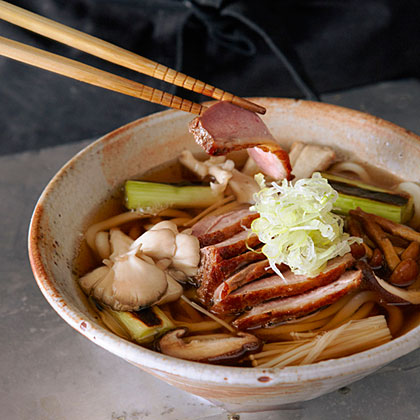

Heat a medium frying pan (not nonstick) or cast-iron skillet over medium heat until very hot. Meanwhile, if cooking duck, score skin in a crosshatch pattern with a very sharp knife, being careful not to cut through the meat. (If cooking chicken, there's no need to score skin.) Pat duck or chicken dry and put in pan, skin side down. Immediately reduce heat to low.
Cook duck slowly, without turning, until most fat has rendered and skin is crisp, 7 to 10 minutes for Pekin (20 for Muscovy), reducing temperature if skin is getting too dark. Turn over and cook until medium-rare (cut to check), 4 to 5 minutes more (8 to 10 for Muscovy). Cook chicken until well browned, 7 to 8 minutes. Turn over, reduce heat to medium-low, and cook through, 7 to 8 minutes more.
Meanwhile, bring soy sauce, mirin, and sake to a boil in a small saucepan over medium-high heat and boil 2 minutes. Let cool. Put poultry in a resealable plastic bag, pour in soy sauce mixture, seal, and chill overnight (1 hour for chicken).
Preheat broiler for poultry and bring a large pot of water to a boil for udon.
Meanwhile, prepare green onions: Cut whole onions into 12 (2-in.) lengths (white and pale green parts only). Heat a small (not nonstick) dry frying pan over medium heat. Cook green onions until charred on two sides, 3 to 4 minutes per side.
Put sliced green onions in a bowl of cold water and vigorously swish around with your fingers to separate into rings. Drain in a fine-mesh strainer. Repeat twice.
Boil udon (see "Udon Essentials," below). Using a large strainer, scoop out noodles into a large bowl and save water to heat soup bowls.
Bring broth to a simmer in a medium saucepan over medium-high heat. Add mushrooms and simmer 2 minutes. Meanwhile, broil duck or chicken, skin side up, until skin begins to crisp, 2 to 4 minutes. Very thinly slice poultry crosswise (if using Muscovy breasts, halve lengthwise first to make small slices).
To serve, warm 4 soup bowls by dipping them into hot udon-cooking water. Divide noodles among bowls and top with duck slices. Arrange 3 charred green onions in each bowl and ladle broth over noodles. Top with sliced green onions.
Udon Essentials Udon (wheat-flour noodles): Store-bought fresh-frozen noodles have a supple texture that's closest to homemade, while the dried ones tend to be thin and flabby. To cook store-bought fresh-frozen udon, drop the frozen block into boiling water. When the water boils again, drain. Cook udon right before serving; the noodles get sticky as they sit.
Make ahead: Broth, up to 2 days, chilled. Green onions, up to 1 day, chilled.
Servings 0
* Percent Daily Values are based on a 2,000 calorie diet. Your daily value may be higher or lower depending on your calorie needs.